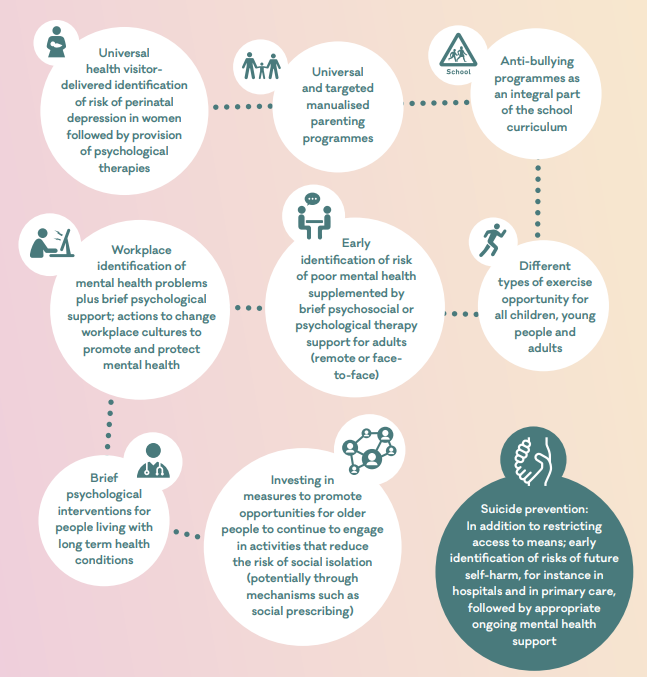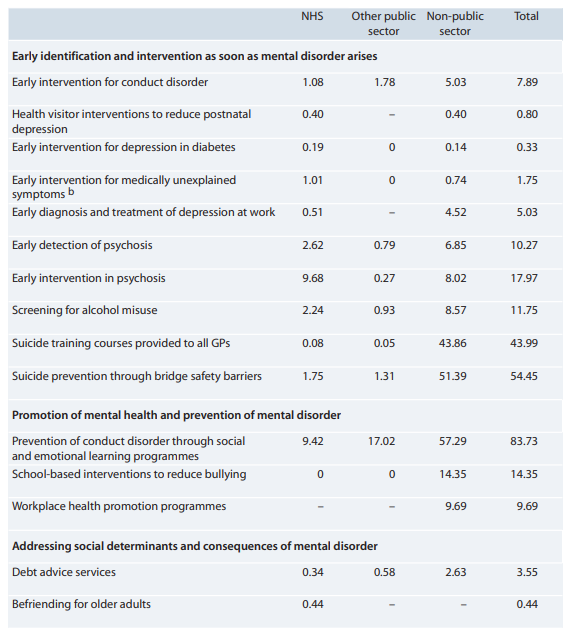Prevention of mental ill-health
There is a large evidence-base around the prevention of mental ill-health (Campion, 2019). There are three main approaches to prevention (Arango et al., 2018). Each level of prevention should aim to proactively address inequalities and meet the needs of population groups currently being underserved by services.
| Type | Aim | Population group | Examples |
| Primary prevention | Reducing risk factors and/or increasing preventative factors, to prevent the development of mental illness | Entire population (universal interventions) | School-based anti-bullying programmes |
| People exposed to inequalities or risk factors (selective interventions) | Social groups for LGBTQ+ youth | ||
| People with early signs of poor mental health (indicated interventions) | Early intervention for people at high clinical risk of psychosis | ||
| Secondary prevention | Early identification and treatment of mental health conditions | People who meet diagnostic criteria for early stages of illness | Screening for postnatal depression |
| Tertiary prevention | Preventing relapse, promoting recovery and improving outcomes | People with mental health condition/s | Annual physical health check for people with severe mental illness |
Prevention in mental health tends to focus on early treatment and reducing the impact of mental health conditions (secondary and tertiary prevention). Few interventions are put in place to prevent the onset of mental health conditions, compared to investments in prevention for physical health conditions such as cardiovascular disease (Arango et al., 2018). It is critical to address this prevention gap between physical and mental health. There is also a substantial treatment gap: most people with mental health conditions in England do not receive any treatment (Campion, 2019).
Each chapter of the mental health strategy includes the evidence base on preventing mental illness. Where possible, information about the strength of evidence base and economic evidence has been included.
Why is prevention important in mental health?
It has been estimated that mental health conditions account for at least 21% of UK disease burden and cost the economy at least £117.9 billion per year (McDaid et al., 2019; Royal College of Psychiatrists, 2022a) . This is due to the high prevalence, early onset, and a broad range of associated impacts of mental health conditions (Royal College of Psychiatrists, 2022a). The prevention and early intervention of mental ill-health is often highly cost-effective (Arango et al., 2018). There is a strong economic case for interventions to prevent mental illness and promote good mental health and wellbeing (Knapp et al., 2011).
Economic evidence
- Mental health is an ‘indispensable part of health’ (World Health Organisation, 2021), with poor mental health impacting individual’s quality of life and life span.
- It has been estimated that mental health problems cost the UK economy at least £118 billion each year, appropriately 5% of the UK GDP in 2019 (McDaid et al., 2022). The majority of these costs are due to the lost productivity of people with mental illnesses and costs incurred by unpaid carers (McDaid et al., 2022).
- This figure is likely to be underestimate as it does not include impacts of presenteeism or absenteeism in the workplace, or the links with physical health conditions (McDaid et al., 2022).
- Comparatively, the NHS spent £16.8 billion on mental health services in 2023/23, including spend on learning disability, autism and dementia services (NHS England, 2023e).
- Mental illness has a substantial impact on the national workforce: mental illness is consistently one of the top five reasons for sickness absence in the UK (Office for National Statistics, 2023) and ‘presenteeism’ due to mental ill-health (in which people still attend work but are less productive) is estimated to account for 1.5 times as much working time lost to absenteeism and to have a significant cost to employers (The Sainsbury Centre for Mental Health, 2007).
- There are close links between poor mental health and physical health conditions, with co-morbid mental health conditions raising total health care costs by an estimated 45% for each person with a long-term physical health condition. It has been estimated that between 12 to 18% of NHS spending on long-term conditions is linked to poor mental health and wellbeing (Naylor et al., 2012).
- The 2010 Marmot review highlighted that health inequalities directly cost the NHS at least £5.5 billion per year. Productivity losses associated with inequalities are thought to be between £31 to £33 billion per year (Marmot, 2010).
Economic case for prevention
The Mental Health Foundation carried out a rapid review of cost-effective interventions to prevent the development of mental health conditions, drawing on systematic reviews as well as individual studies published between 2019 and 2021. This review identified a range of research highlighting the economic benefits of prevention, although the majority of these interventions were aimed at children and young people.
Figure 1: Examples of interventions with a strong evidence base for preventing mental health conditions across the life course. Image source: Mental Health Foundation
Other useful resources include:
- Public Health England’s health economics evidence resource summaries economic evidence for public health interventions.
- The Health Financial Management Association report sets out the steps for NHS finance staff to make the case to address health inequalities
- Public Health England produced a guide for Commissioning Cost-Effective Services for Promotion of Mental Health and Wellbeing and Prevention of Mental Ill-Health
Cost-effectiveness of early intervention and treatment
A 2011 report estimated the savings associated with 15 types of mental health promotion and prevention programmes, looking at savings across the NHS, public sector and wider impacts, across the short, medium and long-term (Knapp et al., 2011). The table below highlights total savings across each of these sectors:
Figure 2: Total returns on investment (economic payoffs per £1 expenditure). Image source: Mental health promotion and mental illness prevention: The economic case
As highlighted above, there are significant short and longer-term economic benefits of early intervention in psychosis (EIP) services. The net cost savings per person after the first four years is £7,972, with a further £6,780 saving per person in the next four to 10 years if full EIP provisions are provided. Over a 10-year period this would result in £15 of costs saved for every £1 invested (Public Health England, 2019): The majority of these savings are due to:
- the reduction in use of crisis and inpatient services.
- improved employment outcomes.
- the reduction in risk of future hospitalisation as a result of improved management and reduced risk of relapse.
Financial opportunities
The GIRFT report has identified financial opportunities linked to MH crisis and acute services relating to:
- Improve community-based care and local inpatient capacity, to reduce out of area placements
- Ensure existing staff capacity is efficiently utilised and train sufficient numbers of professionally qualified staff, to reduce bank and agency costs
- Reduction in patients that present to Accident and Emergency 24 hours or less, prior to admission, to reduce Accident and Emergency attendances
- Reduce unexplained variation in admissions under the Mental Health Act, to reduce admissions under the Mental Health Act
- Most short-stay hospital cases could and should receive better care in the community, to reduce proportion of short stay hospital admissions (0-3 days length of stay)
- Ensure people do not become stranded in community teams or inpatient services, to reduce length of stay of patients staying over 60 days
The experience of people with lived experience and local staff may provide opportunities to better understand these areas for improvement.
What is public mental health?
Public mental health can be defined as (Royal College of Psychiatrists, 2022a):
- involving a population-based approach that seeks to improve the level and distribution of mental ill-health and mental wellbeing in society.
- supporting improved implementation of public mental health interventions at primary, secondary and tertiary
- Including more targeted approaches to prevent widening of inequalities for groups at increased risk of mental disorder, poor mental wellbeing and/or reduced access to interventions. Such targeted approaches are supported by, for example, being culturally appropriate.
- Promoting coordinated and intersectoral approaches between providers of different types of intervention, including social, educational, workplace, health, economic and policy.
- involving people with experience of mental disorders and their carers, communities, providers, commissioners, policymakers and industry (public, non-profit and for-profit institutions) in the development and implementation of evidence-based interventions.
There are evidence-based public mental health interventions, including primary, secondary and tertiary prevention (Campion, 2019). This may include cross-sector working to address wider determinants of poor mental health, such as poverty and domestic abuse.
Interventions to promote mental wellbeing
Some interventions that promote mental wellbeing overlap with interventions to treat mental health conditions. However, being free from mental illness is not necessarily the same as having good mental wellbeing, and vice versa. Therefore, there needs to be distinct approaches to promoting mental wellbeing in the population and to preventing mental illness (Campion, 2019).
Additional resources
- In Cambridgeshire and Peterborough, the Joint Health and Wellbeing Integrated Care Strategy aims to prevent mental illness and promote mental wellbeing in the local population.
- Better Mental Health For All gives a detailed summary of the evidence base around prevention, including the strength of the evidence
- Prevention and mental health: Understanding the evidence so that we can address the greatest health challenge of our times gives a summary of the evidence base around prevention
Resources for commissioners
- Public mental health: Evidence, practice and commissioning (see pages 109 – 114 for economic evidence)
- Guidance for commissioning public mental health services and cost-effective commissioning
Economic evidence
- The economic case for investing in the prevention of mental health conditions in the UK
- Mental health promotion and mental illness prevention: The economic case
- Mental health investment case: a guidance note describes how to make an investment case for mental health interventions
- Investment priorities for MH from the Centre for Mental Health
- RHO Cost of racism
Public mental health
- Public mental health implementation: A new centre and new opportunities highlights the importance of public mental health
- Training in Public Mental Health


